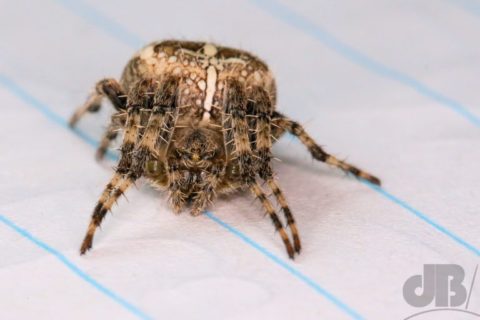Cross, or European Garden, Spider (Araneus diadematus), also known as the Crowned Orb Weaver, Diadem, Orangie, and also the Pumpkin Spider, so perhaps I should’ve held off posting this until Halloween. There is, however, another spider that has the vernacular name Pumpkin Spider.

This is a female specimen. The legs of orb-weaver spiders are specialized for spinning orb webs (although this one had spun a flat web across a small windowpane). The spider constructs its web and then hangs head down in the centre or in nearby foliage, with one claw hooked to a signal line connected to the web waiting for a disturbance as prey enters the web. The spider bites its prey and quickly envelops it in silk. Some enzymes paralyse the prey and preclude the prey biting or stinging the spider. Other enzymes begin the liquefaction (digestion) of the prey’s innards ready for consumption.
Just for the record, this is one of those spiders that cannibalises the male after mating.
I asked arachnid expert Dr Richard Pearce (@DrRichJP) about the fact that spiders seem to have extra pairs of eyes and wondering why other creatures did not follow this evolutionary route. This is what he had to say:
Spider eyes are not necessarily comparable to our own. Many spiders have poor vision. Those with good vision tend to have two primary eyes to give binocular vision (e.g. jumpers - Salticidae; wolf spiders - Lycosidae). The other eyes do not form images in the same way.
Spider photo now in my Invertebrates gallery (non-lepidoptera)